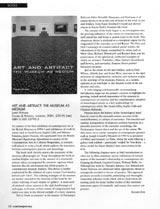| |
|
 |
 |
 |
 |
 |
|
'Art and Artifact: The
Museum as Medium' by James Putnam, Thames & Hudson £29.95 (HBK), ISBN 0 500 23790 5
reviewed by Richard Dyer, Contemporary, January, 2002.
As curator of the first exhibition of contemporary art at the British Museum in 1994-5 and exhibitions of work by artists such as Sarah Lucas, Sophie Calle and Mimmo Paladino, James Putnam, who graduated form the British Museum’s Egyptology department to curator of the Contemporary Arts & Culture Programme, is certainly well placed to write a book which explores the interstices between contemporary practice and museology.
The book itself cleverly mimics the taxonomy of the museum; photographs are ‘hung’ throughout the book at random heights and sizes in the manner of a nineteenth-century salon, accompanied by extensive captions which function like the information-rich labels popular in contemporary museum displays. This device is further emphasized by the addition of a grey trompe l’oeil shadow behind each ‘label’. The ordering strategies of the museum are further encoded in the structure of the book by the colour indexing of each chapter or ‘gallery’. A semi-circle of etiolated colour appears in the right-hand margin of each page, as if some archaic system of categorization had faded over time in the filtered sunlight of a dusty museum.
This is ‘book as museum’ in the manner of Duchamp’s Boite-en-Valise (Portable Museum), and Duchamp is of course shown to be at the core of much of the work in Art and Artifact, from Haim Steinbach’s found and shelved objects to Gavin Turk’s Fountain-like Font.
The concept of the book began as an investigation into the growing utilization of the vitrine in contemporary art, and indeed this still forms a central trope in the book. This ubiquitous device is analysed as a conceptual engine for the reappraisal of the everyday, as in Jeff Koom’s The New and Neil Cumming’s de-commercialised plastic bottles; the valorization of the banal, exemplified by artists such as Mark Dion, Richard Wentworth and Karsten Bott; and the preservation of the ephemeral, celebrated examples of which are Arman’s ‘Poubelles’, Marc Quinn’s blood-heads and flowers, and inevitably, Damien Hirst’s pickled farmyard carcasses.
Just as the artists in Art and Artifact, such as Fred Wilson, Alfredo Jaar and Franz West, intervene in the rigid structures of categorization, exclusion and inclusion at play in the aetiology of the museum, Putnam, as a curator, operates as an interloper in the closed world of the art-theorist and critic.
A wide-ranging and historically contextualizing introduction maps out his primary concern: to highlight the growing, indeed central importance of the museum to contemporary art practice and the complimentary adoption of museological praxis as a key methodology by contemporary artists like Susan Hiller, Sophie Calle and Christian Boltanski.
Putnam traces the history of the ‘museological muse’ from its roots in the sixteen-century practice of the wunderkammer, or cabinet of curiosities. This fanciful and random juxtaposition of disparate artifacts functions as a plausible precursor of the surrealist assemblage, the Duchampian found object and the art of the vitrine. We then move on to earlier examples of contemporary practice such as Joseph Cornell’s Museum of 1944-8 (a precursor of Hiller), and Arman’s Le Plein, where the artist filled up a gallery with rubbish –previously ‘voided’ by Yves Klein- a direct model for Stuart Brisley’s later intervention at the ICA.
The following chapters serve as brief introductions to what are in effect miniature survey exhibitions of various aspects of the museum’s relationship to contemporary art; Framing the Frame, Curator/Creator, Without Walls, etc. Although key texts by Theodor Adorno, Guy Debord and Andre Malraux are referenced when appropriate, theory is strategically avoided in favour of practice. This approach produces an easily accessible, stimulating and thoroughly researched reference work which will no doubt form the starting point for many further studies of this extremely important aspect of twentieth- and twenty-first century art practice.
|
 |
| |
 |
 |
|
|